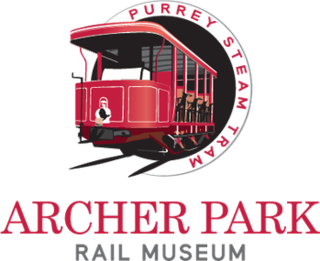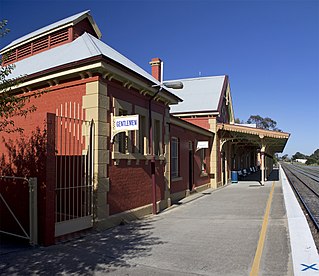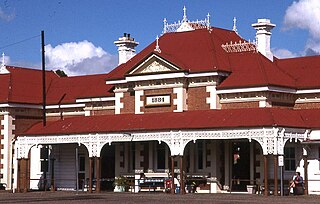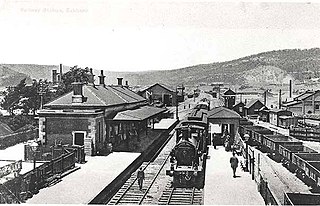
Archer Park Railway Museum is a heritage-listed former railway station and now transport museum at Denison Street, Rockhampton, Rockhampton Region, Queensland, Australia. It was built from 1897 to 1908. It was known as Archer Park railway station and Rockhampton Central railway station. It was added to the Queensland Heritage Register on 21 October 1992.

Wollongong railway station is a heritage-listed railway station on the South Coast railway line in New South Wales, Australia. It serves the central business district of Wollongong. It was added to the New South Wales State Heritage Register on 2 April 1999.

Muswellbrook railway station is a heritage-listed railway station located on the Main Northern line in Muswellbrook, in the Muswellbrook Shire local government area of New South Wales, Australia. The station serves the town of Muswellbrook and was designed by John Whitton, the Chief Engineer of NSW Railways. It is also known as Muswellbrook Railway Station and yard group and Musclebrook Railway Station. The property was added to the New South Wales State Heritage Register on 2 April 1999.

Queanbeyan railway station is a heritage-listed railway station located on the Bombala line in New South Wales, Australia. It serves the town of Queanbeyan.

Albury railway station is a heritage-listed railway station at Railway Place, Albury, New South Wales, Australia, adjacent to the border with Victoria, in Australia. It was designed under the direction of John Whitton and built from 1880 to 1881. It was added to the New South Wales State Heritage Register in 1999.

Parkes railway station is a heritage-listed former locomotive depot and railway station and now locomotive roundhouse and railway station located on the Broken Hill line in May Street, Parkes in the Parkes Shire local government area of New South Wales, Australia. The railway station serves the town of Parkes and was built from 1881 to 1893. It is also known as the Parkes Railway Station group. The property was added to the New South Wales State Heritage Register on 2 April 1999.

Armidale railway station is a heritage-listed railway station at 240 Brown Street, Armidale, New South Wales, Australia. It was built from 1882 to 1883 by Edmund Lonsdale and Henry Sheldon Hoddard, and was opened on 3 February 1883 when the line was extended from Uralla. It was the terminus of the line until it was extended to Glen Innes on 19 August 1884. It was added to the New South Wales State Heritage Register on 2 April 1999.

Mount Morgan railway station is a heritage-listed railway station at Railway Parade, Mount Morgan, Rockhampton Region, Queensland, Australia. It is on the Mount Morgan - Wowan railway line. The station was constructed in 1898 to service the former goldrush and gold mining township of Mount Morgan and its mine. The station was designed by Henrik Hansen, who also designed the Archer Park, Shorncliffe and South Brisbane railway stations. The station operated as a functional railway station from 1898 until 1987, after which it was restored as a Railway Heritage Museum. The museum includes artefacts from the rail and mining history of Mount Morgan, including a restored Hunslett steam engine, "Silver Bullet" rail motor and timber rail carriages. The station was added to the Queensland Heritage Register on 21 October 1992.

Toowoomba railway station is a heritage-listed railway station on the Western line at Russell Street, Toowoomba, Toowoomba Region, Queensland, Australia. It serves the city of Toowoomba, which is the junction for the Western, Main and Southern lines. The station has one platform with a passing loop, opening in 1867. It was designed by FDG Stanley and built in 1873 by R. Godsall. It was added to the Queensland Heritage Register on 21 October 1992.

Mitchell railway station is located on the Western line in the Maranoa Region, Queensland, Australia. It serves the town of Mitchell. The station has one platform, opening in 1885. The station has a number of heritage-listed buildings, including the passenger station in Oxford Street, the goods shed in Alice Street, and the station master's house in Sheffield Street. The buildings were added to Queensland Heritage Register on 8 September 2005.

Charleville railway station is a heritage-listed railway station on the Western line at King Street, Charleville, Shire of Murweh, Queensland, Australia. It was built from 1888 to 1957. It was added to the Queensland Heritage Register on 12 July 2005.

Maryborough railway station is a heritage-listed railway station at Lennox Street, Maryborough, Fraser Coast Region, Queensland, Australia. It is on the North Coast line serving the city of Maryborough. It was designed by Chief Engineer of the Queensland Railways Department and built from 1878 to 1890 by John Roddam & John Walker. It was added to the Queensland Heritage Register on 21 October 1992.

Wallangarra railway station is a heritage-listed railway station at Woodlawn Street, Wallangarra, Southern Downs Region, Queensland, Australia. It was built in 1877 along the state border of Queensland and New South Wales It was added to the Queensland Heritage Register on 28 March 2003.

Narrandera railway station is a heritage-listed railway station located at Whitton Street, Narrandera, Narrandera Shire, New South Wales, Australia. It is situated on the Hay railway line, and was formerly the junction station for the Tocumwal railway line. It was built in 1880 by Charles Hardy to a design attributed to John Whitton. The property was added to the New South Wales State Heritage Register on 2 April 1999.

Warwick railway station is a heritage-listed railway station on the Southern railway line in Warwick, Southern Downs Region, Queensland, Australia. It was built from c. 1881 to 1910s. It was added to the Queensland Heritage Register on 24 September 1999.

Longreach railway station is the terminus station of the Central Western line, serving the town of Longreach, Longreach Region, Queensland, Australia. It is on the Landsborough Highway. It was built from 1887 to 1917. It was added to the Queensland Heritage Register on 12 December 2005.

Normanton railway station is a heritage-listed railway station at Matilda Street, Normanton, Shire of Carpentaria, Queensland, Australia. It was built in 1889. It was added to the Queensland Heritage Register on 21 October 1992. It serves as a tourist attraction and station for the Gulflander line.

The Cooma railway station is a heritage-listed former railway station on the Bombala railway line at Bradley Street, Cooma, Snowy Monaro Regional Council, New South Wales, Australia. The original design of the station was attributed to John Whitton. The station complex was built from 1889 to 1950. The Cooma Monaro Railway is based at the station and is opening a heritage railway museum in the restored station building in December 2022. The station was added to the New South Wales State Heritage Register on 2 April 1999.

Mudgee railway station is a heritage-listed former railway station on the Gwabegar railway line at Mudgee, Mid-Western Regional Council, New South Wales, Australia. It was designed by John Whitton and built from 1883 to 1884. The property was added to the New South Wales State Heritage Register on 2 April 1999.

The Eskbank railway station is a heritage-listed former locomotive depot and railway station and now community group venue adjacent to the Main Western Line at Lithgow, City of Lithgow, New South Wales, Australia. It was designed by the New South Wales Government Railways and the station building was built by Goodsell & Wright, as a contractor. It is also known as Eskbank Railway Station group and Lithgow Goods Station/ Lithgow Site S1. The property was added to the New South Wales State Heritage Register on 2 April 1999.
























